In 1918, at just 20 years of age 1, Alice Anderson founded ‘Miss Anderson’s Motor Service’, which would go on to become Victoria’s first all female motor garage.2 Her vision, as she would later tell magazine Woman’s World, was ‘to turn a trade into a profession for women,’ an aspiration she felt was ‘well within the grasp’ of those with ‘initiative and grit.’3
 Alice Anderson wearing chauffer uniform, ca 1918. Courtesy of University of Melbourne Archives; 1988.0061.01551
Alice Anderson wearing chauffer uniform, ca 1918. Courtesy of University of Melbourne Archives; 1988.0061.01551
Alice had never been one to conform to convention. Born in Malvern in 1897, Alice was the third of five children to Irish Protestant parents. The Andersons lived overseas for several years, before returning and settling in Narbethong, where Alice was, according to her sisters, allowed to ‘run wild’ 4 – hunting rabbits and fishing, and rambling in the forest with her brother, Stewart. 5 When Alice was fifteen, a local timber worker knocked on the Anderson’s door asking to use a telephone. One of his fellow workers had come to work drunk and accidentally cut his own throat with a broken beer bottle. According to family legend, quick-thinking Alice saved the man’s life by stitching the wound up with a sterilised thread from her horse’s tail.6
Alice’s education was a short-lived affair. She spent five terms as a day student at the Church of England Grammar School before her parents’ finances ran out, and she was forced to leave. She began keeping the books for her father’s business: the Blacks’ Spur Motor Service, where the bus drivers took Alice under their wing – teaching her how to drive and repair the charabancs.78
In 1916, Alice became the first woman motorist to drive the dangerous Blacks’ Spur road between Healesville and Narbethong,9 which was, according to her father’s bus drivers, ‘no place for a woman …’10
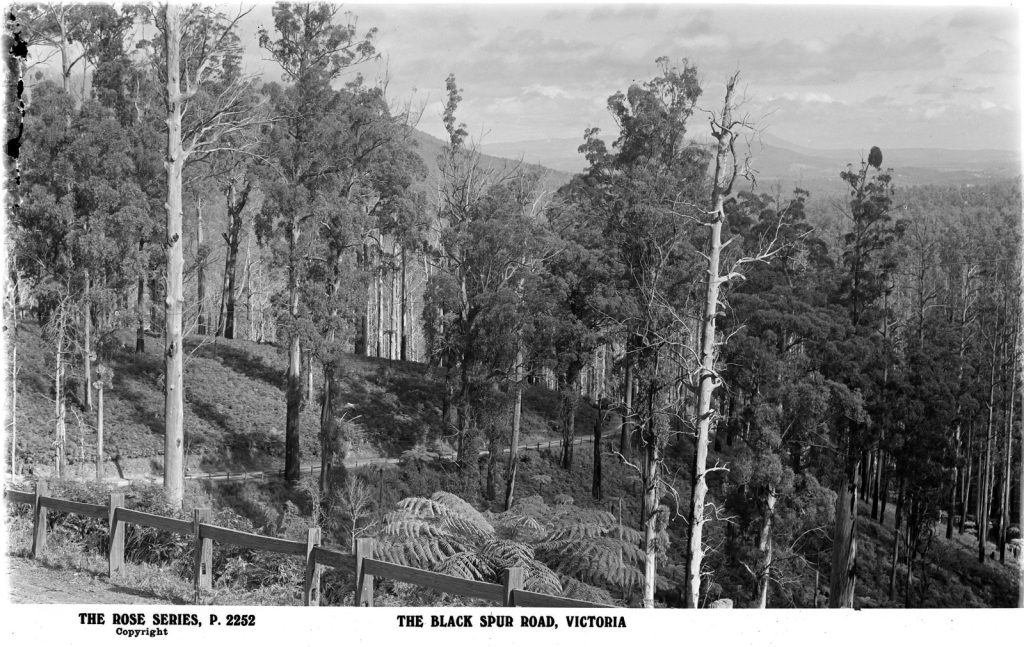 The Black Spur Road, Vic; H32492/3155
The Black Spur Road, Vic; H32492/3155
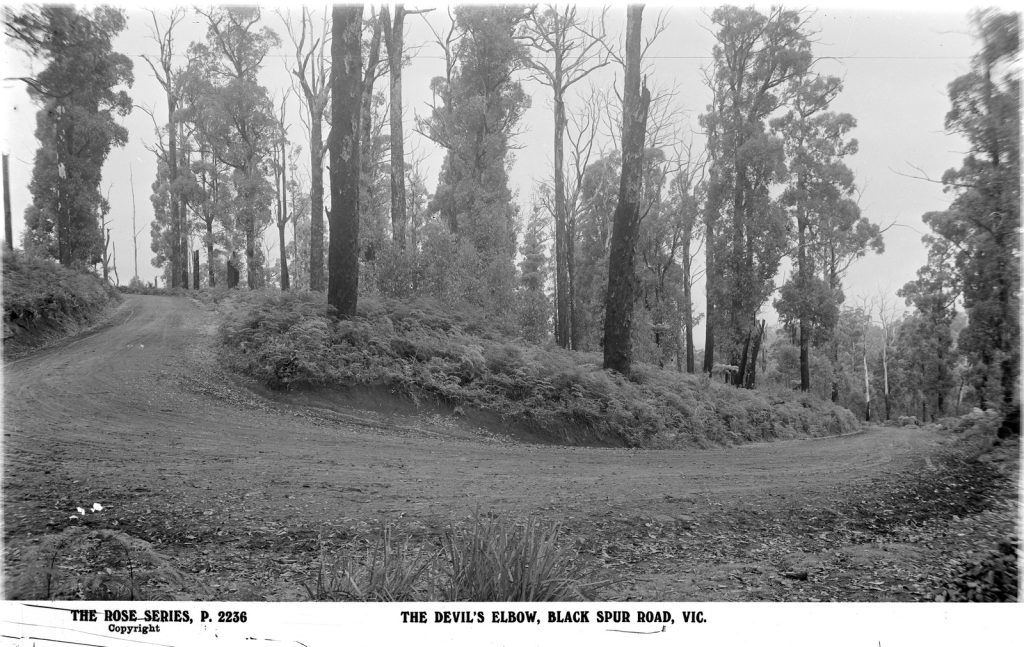 The Devil’s Elbow, Black Spur Road, Vic; H32492/3149
The Devil’s Elbow, Black Spur Road, Vic; H32492/3149
When Alice turned 18, her father gave her a 7-seater Hupmobile touring car as a present, although she soon discovered there were strings attached. Her father had only paid the deposit, leaving Alice to pay off the 350 pound balance. 11 Determined to keep the car, Alice found an office job, and utilised her touring car on the side – driving tourists to the bush for weekend picnics.12
As a female chauffeuse, Alice was in demand. Parents enlisted her to drive their daughters safely home from dances, country women employed her to take them on shopping excursions, and expectant mothers trusted her to take them to hospital. 13 During World War I, Alice joined other volunteer motorists, transporting wounded soldiers from troop ships to hospital, or home to their families.14
Alice undertook an apprenticeship at a Melbourne garage and became a mechanic. In 1918, she successfully petitioned her landlord for permission to run a motor garage out of her back shed, in Kew, and from that point on, she never looked back. As she told magazine, Woman’s World, ‘I got the opportunity to vacate the office stool for the wheel – and I took it.’ 15

 Advertisement for Alice Anderson’s Motor Service from Sands & McDougall directory of Victoria, 1919
Advertisement for Alice Anderson’s Motor Service from Sands & McDougall directory of Victoria, 1919
A year later, Alice had raised enough money to put a deposit on a nearby block of land and build a new garage for her business, to her own specifications. 16 ‘Miss Anderson’s Motor Service’ offered vehicle servicing and repairs, petrol sales, a 24-hour chauffeur service (staffed by chauffeuses) and interstate road trips for adventurous tourists. Alice’s generous catering for her touring parties became renowned, with the Truth reporting that: ‘… she always carries a hamper of chicken, ham, fruit, cream and, in fact, everything that a picknicker’s heart could desire.’ (3 May 1925, p 14)17
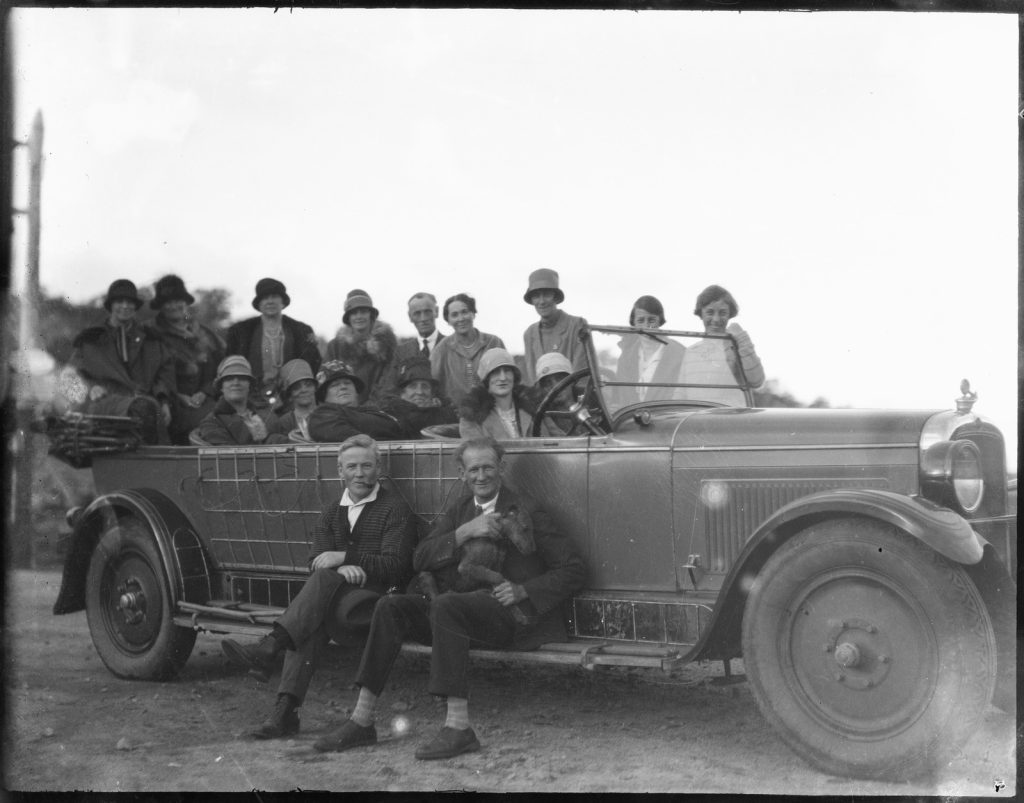 Group of women in open touring car, two men, one with dog, seated on the running board, Mount Buffalo, Vic; H2003.97/265. Touring cars were a popular form of entertainment in the early 20th century.
Group of women in open touring car, two men, one with dog, seated on the running board, Mount Buffalo, Vic; H2003.97/265. Touring cars were a popular form of entertainment in the early 20th century.
Alice’s all-woman garage also offered driving lessons for women, mechanical instruction, and vehicle appraisals for women looking to purchase their own car. 18
By 1925, Alice owned a fleet of seven cars, and employed eight chauffeuses. Initally, Alice would take a girl on at the garage for a three-month trial. If she showed potential, she would apprentice her as a chauffeuse. 19 Only a select number of girls would make the grade, with those who were ill-suited inevitably falling away.
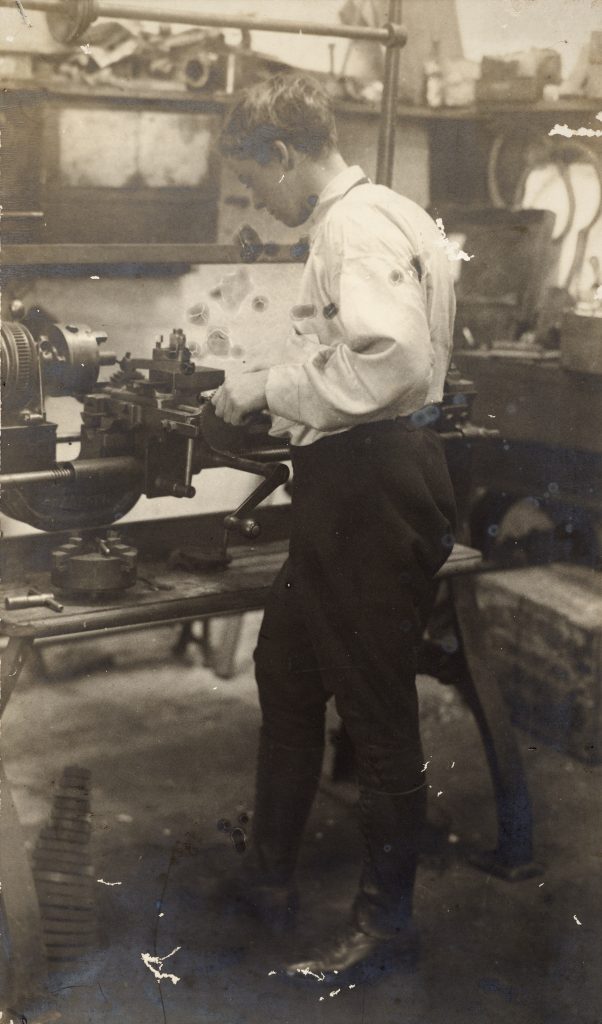 Alice Anderson in the Kew Garage workshop working at lathe. Courtesy of University of Melbourne Archives, 1988.0061.01556
Alice Anderson in the Kew Garage workshop working at lathe. Courtesy of University of Melbourne Archives, 1988.0061.01556
According to an article in the Australian Women’s Mirror, the qualities of a ‘successful motor girl’ included: ‘patience, good temper, reliability, a certain amount of daring, but good judgement also to know when taking a risk is justifiable and when not.’ 20
Alice and her chauffeuses were famous throughout the eastern suburbs, partly for their unconventional occupation, and partly for their manly dress. Alice’s chauffeuses wore a uniform of brown breeches and leggings, top coat and motorists caps, and Alice was known for her boyish appearance. ‘Skirts and hair have gone’, the Australian motorist reported of Alice. ‘She has donned male attire, and a woman’s chief worry, her hair, has been cut closely, and she will now pass for a youth of 18 or 19 years of age.’21
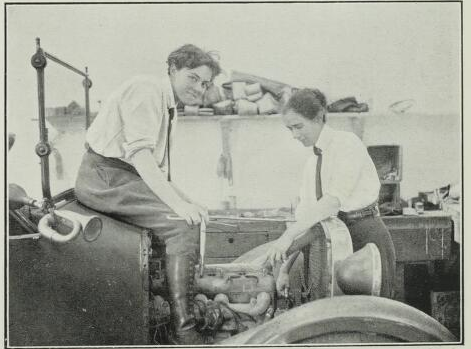 Miss Anderson’s assistants at work in the garage. Photo from The Home, 1 December 1920, p 74
Miss Anderson’s assistants at work in the garage. Photo from The Home, 1 December 1920, p 74
Alice was often featured in the press, and wrote articles about motoring in Woman’s World. She was made a member of the prestigious Lyceum Club, ‘for her services to womankind in pioneering a new industry for women.’ (Truth, 3 May 1925, p 14) She was also known for an invention she coined the ‘Anderson get-out and get-under’ device – a platform on wheels designed for motorists to use in the advent of a breakdown.22
In 1926, Alice embarked on a motor trip to Alice Springs with friend and fellow Lyceum Club member Jessie Webb. A small band of friends turned out in the chilly Melbourne evening to see them off, their Baby Austin laden with baggage. A labourer’s spade had been strapped to the front of the vehicle, and Alice had removed the car doors so that the sides were open. (News, 11 August 1926, p 4)
It took the women six weeks to reach their destination, with Alice sending updates to her sponsors along the way:
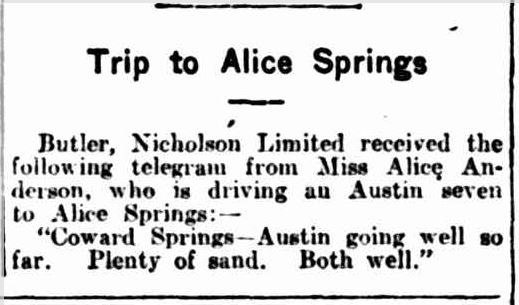 News, 17 August 1926, p 11
News, 17 August 1926, p 11
When the women reached Alice Springs, the following telegram from Alice appeared in the newspaper:
‘Twelve gallons petrol used by Baby Austin for Oodnadatta to Alice Springs. Did the distance in three days without a hitch. Ahead of others. Perfect car.’ (News, 24 August 1926, p 9)
On her return home, Alice gave an expansive interview to the Herald, where she recounted her amazement at the enormous distances in Central Australia, the large numbers of returned soldiers taking up land, and the lack of available drinking water. She marvelled too, at the beauty of the desert, describing the wildflowers in vivid detail:
There were patches of royal purple peas that spread over the ground like a thick carpet. Then there were the marshmallows, bearing a mauve or pink flower on tall stalks … Further on there were scarlet peas that in the distance looked like bright parrots squatting on the roadside. Among the spinifex there were very large yellow daisies and white everlastings centred in yellow. (Herald, 14 September 1926, p 14)
Just three days later, Alice was dead. She had been cleaning an automatic pistol in the garage when it went off accidentally and shot her through the head.23
 The Herald, 18 September 1926, p 1
The Herald, 18 September 1926, p 1
Her death was met with widespread sadness, and disbelief. ‘Her death in such circumstances is a great shock to us and we’ll miss her terribly,’ one of her garage girls said.24 Mourners sent hundreds of wreaths of flowers to Alice’s home, ‘Lancewood’ in Glenferrie, and tributes flooded the newspapers, with the Herald reporting that: ‘Probably no woman in Melbourne was better known.’ (18 September 1926, p 1)
Alice was laid to rest on 20 September at Boroondara cemetery. Her girls wore their uniforms and acted as her pallbearers, but the following day they were back in the garage, hard at work. Alice’s father, J.T. Anderson, believed it was what Alice would have wanted, and her sole executor, Sister J. McBeth agreed. (Herald, 21 September 1926, p 1)
Alice’s garage continued to operate until the 1940s, when the last of the women left to serve in World War II, and the garage closed its doors for good.
Further reading
Clarsen, Georgine, 2008, Eat my dust: early women motorists, The Johns Hopkins University Press, Baltimore, Maryland
Colligan, Mimi, 1985, ‘Alice Anderson: garage proprietor’ in Lake, M & Farley, K (Eds) (1985), Double time: women in Victoria, 150 years, Penguin Books, Australia, p 308
Smith, Loretta, 2019, A spanner in the works. The extraordinary story of Alice Anderson and Australia’s first all-girl garage, Hachette Australia, Sydney, NSW
References
- Lemon, Barbara, 2008, Anderson, Alice Elizabeth Foley, The Australian Women’s Register, viewed 5 August 2022; Clarsen, Georgine, 2005, ‘Alice Elizabeth Anderson (1897-1926)’, Australian Dictionary Biography, viewed 5 August 2022
- Clarsen, Georgine, 2005, ‘Anderson, Alice Elizabeth (1897 – 1926)’, Australian Dictionary of Biography, accessed 5 August 2022
- Woman’s World, 1 February 1922, p 13
- Clarsen, G, 2008, Eat my dust: early women motorists, John Hopkins University Press, Baltimore
- Smith, L, 2019, A spanner in the works. The extraordinary story of Alice Anderson and Australia’s first all-girl garage, Hachette Australia, Sydney, NSW, pp 61-63
- As above, pp 78-79
- Charabancs were big heavy buses
- Smith, L, 2019, A spanner in the works. The extraordinary story of Alice Anderson and Australia’s first all-girl garage, Hachette Australia, Sydney, NSW, pp 107-110
- As above, p 112-113
- Woman’s World, 1 May 1926, p 341
- Smith, L, 2019, A spanner in the works. The extraordinary story of Alice Anderson and Australia’s first all-girl garage, Hachette Australia, Sydney, NSW, p 103
- As above, p 117-118
- As above, p 120
- Colligan, M, 1985, ‘Alice Anderson: garage proprietor’ in M Lake & K Farley, (eds), Double time: women in Victoria, 150 years, Penguin Books, Australia, p 308; Smith, L, 2019, A spanner in the works. The extraordinary story of Alice Anderson and Australia’s first all-girl garage, Hachette Australia, Sydney, NSW, pp 151-152
- Woman’s World, 1 Feb, 1922, p 13; Smith, L, 2019, A spanner in the works. The extraordinary story of Alice Anderson and Australia’s first all-girl garage, Hachette Australia, Sydney, NSW, pp 158-160
- Australian motorist, 2 June 1919, p 71
- Smith, as above, p 187
- Smith, as above, pp 201-206
- Brodie, JM, 1925, ‘Woman the car’, The Australian woman’s mirror, vol 1, no 48, p 9
- As above
- Australian Motorist, 2 June 1919, p 71
- According to an article that was published in The Mercury on 6 September 1922, Alice’s invention was thwarted after she shared it with a visiting American, and it was patented by a US firm.
- ‘Kew garage fatality,’ Age, 1 October 1926, p 15
- ‘Miss Anderson’s Death,’ Herald, 18 September 1926, p 1


What a magic story with such a tragic ending. Oh how I wish I had known her!
“A Spanner in the Works” is a great read.
I find it very hard to believe that her death was accidental, let alone suicide…
Fabulous story and pix
A progressive woman, ahead of her time. There’s also an article on Alice in “Grave Tales: Melbourne Vol 1” by Helen Goltz. It inspired me to visit her gravesite at the Boroondara Cemetery in Kew
I am Alice Anderson’s great niece and like Susan I would love to have known her.
She was intelligent, resourceful and brave and I highly recommend the biography
A Spanner in the Works by Loretta Smith
I had driving lessons in 1966 with the Alice Anderson Driving School and my instructor commented that the greatest compliment a female driver can have is that the male driver behind her doesn’t overtake. I think Alice Anderson would have turned in her grave.
Three cheers for Alice and her family and well wishers who gave her support despite the strangling conventions of the time.
The intelligence, persistence and practicality of Alice Anderson was an inspiration for many women. What an amazing girl she was and how wonderful that she created such a successful garage and chauffeuring business because of her own insistence on excellence in the mechanics of the motors that she accumulated and used for her chauffeuring expeditions. No wonder she was popular in Melbourne. Her death was a shocking tragedy, but she left a great legacy for the women in her employ.
This is a delight to read, Sarah! Please keep them coming.
Thanks Judy! I’m glad you enjoyed it. Sarah
Loved this story and the history informing it. The images are terrific too. Thanks Sarah!
Loved the story.
What inspiring story Sarah, thank you. She left such great role model for many to follow. It makes you admire more the very many unsung heroines that open up the easy path of our generation in this wonderful country.
Wow I was shocked and in such awe of Miss Anderson I guess it was her time but I can’t help to think of what she was going to do next!! Thankyou for this wonderful story! Her business sense is an inspiration and especially for the times!
Thanks for the great article. There’s also a chapter about Alice and her grave in “Grave Tales: Melbourne. Volume 1” by Helen Goltz & Chris Adams, 2020. It inspired me to visit Alice’s grave at the Boroondara Cemetery in Kew.
Wonderfull story.
I did part of my Motor Mechanics Apprenticeship in her garage after it was taken over by B S Stillwell.
I feel conected to Alice.
Amy